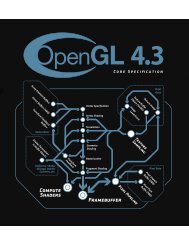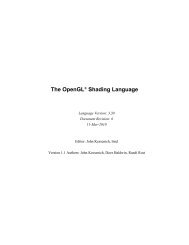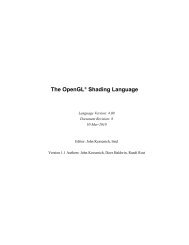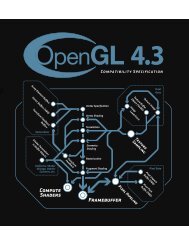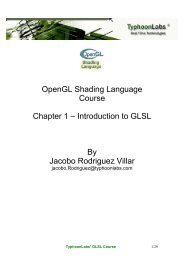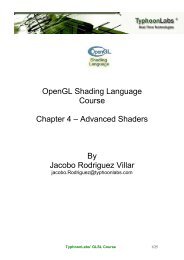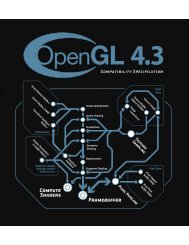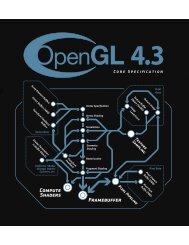OpenGLTM and X, Part 2: Using OpenGL with Xlib
OpenGLTM and X, Part 2: Using OpenGL with Xlib
OpenGLTM and X, Part 2: Using OpenGL with Xlib
Create successful ePaper yourself
Turn your PDF publications into a flip-book with our unique Google optimized e-Paper software.
.<br />
ow the window has been created, the <strong>OpenGL</strong> renderer<br />
has been bound to it, the display lists have been constructed,<br />
<strong>and</strong> <strong>OpenGL</strong>'s state has been congured. All<br />
that remains is to request the window be mapped using<br />
ap indo <strong>and</strong> begin h<strong>and</strong>ling any X events sent to the<br />
program.<br />
When the window was created, four types of window<br />
events were requested to be sent to our application:<br />
xpose events reporting regions of the window to be<br />
drawn, utton ress events indicating mouse button status,<br />
ey ress events indicating a keyboard key has been<br />
presed, otion oti y events indicating mouse movement,<br />
<strong>and</strong> on igure oti y events indicating the window's size<br />
or position has changed.<br />
X event dispatching is usually done in an innite loop.<br />
Most X programs do not stop dispatching events until the<br />
program terminates. ext ent can be used to block<br />
waiting for an X event. When an event arrives, its type is<br />
examined to tell what event has been received.<br />
. .<br />
For an xpose event, the example program ust sets a ag<br />
indicating the window needs to be redrawn. The reason is<br />
that xpose events indicate a single sub-rectangle in the<br />
window that must be redrawn. The X server will send a<br />
number of xpose events if a complex region of the window<br />
has been exposed.<br />
For a normal X program using 2D rendering, you might<br />
be able to minimize the amount needed to redraw the window<br />
by carefully examining the rectangles for each xpose<br />
event. For 3D programs, this is usually too di cult to be<br />
worthwhile since it is hard to determine what would need<br />
to be done to redraw some sub-region of the window. In<br />
practice the window is usually redrawn in its entirety. For<br />
the dinosaur example, redrawing involves calling the dinosaur<br />
display list <strong>with</strong> the right view. It is not helpful to<br />
know only a sub-region of the window actually needs to be<br />
redrawn. For this reason, an <strong>OpenGL</strong> program should not<br />
begin redrawing until it has received all the expose events<br />
most recently sent to the window. This practice is known<br />
as e ose co ress on <strong>and</strong> helps to avoid redrawing more<br />
than you should.<br />
otice that all that is done to immediately h<strong>and</strong>le an<br />
expose is to set the need edra ag. Then ending is<br />
used to determine if there are more events pending. ot<br />
until the stream of events pauses is the redra routine<br />
really called (<strong>and</strong> the need edra ag reset).<br />
The redra routine does three things: it clears the image<br />
<strong>and</strong> depth buers, executes the dinosaur display list,<br />
<strong>and</strong> either calls gl ap u ers on the window if double<br />
buered or calls gl lus . The current model-view matrix<br />
determines in what orientation the dinosaur is drawn.<br />
. .<br />
The X server sends a on igure oti y event to indicate<br />
a window resize. H<strong>and</strong>ling the event generally requires<br />
changing the viewport of <strong>OpenGL</strong> windows. The sample<br />
program calls gl ie port specifying the window's new<br />
width <strong>and</strong> height. A resize also necessitates a screen redraw<br />
so the code falls through to the expose code which<br />
sets the need edra ag.<br />
When you resize the window, the aspect ratio of the<br />
window may change (unless you have negotiated a xed<br />
aspect ratio <strong>with</strong> the window manager as the - eepaspect<br />
option does). If you want the aspect ratio of your nal<br />
image to remain constant, you might need to respecify the<br />
pro ection matrix <strong>with</strong> an aspect ratio to compensate for<br />
the window's changed aspect ratio. The example does not<br />
do this.<br />
. .<br />
The example program allows the user to rotate the dinosaur<br />
while moving the mouse by holding down the rst<br />
mouse button. We record the current angle of rotation<br />
whenever a mouse button state changes. As the mouse<br />
moves while the rst mouse button is held down, the angle<br />
is recalculated. A recalc odel ie ag is set indicating<br />
the scene should be redrawn <strong>with</strong> the new angle.<br />
When there is a lull in events, the model-view matrix<br />
is recalculated <strong>and</strong> then the need edra ag is set, forcing<br />
a redraw. The recalc odel ie ag is cleared. As<br />
discussed earlier, recalculating the model-view is done by<br />
popping o the current top matrix using gl op atrix <strong>and</strong><br />
pushing on a new matrix. This new matrix is composed<br />
<strong>with</strong> a rotation matrix using gl otate to reect the new<br />
absolute angle of rotation. An alternative approach would<br />
be to multiply the current matrix by a rotation matrix<br />
reecting the change in angle of rotation. But such a relative<br />
approach to rotation can lead to inaccurate rotations<br />
due to accumulated oating point round-o errors.<br />
. .<br />
Because the<br />
atom was specied on the<br />
top-level window's list of window manager protocols, the<br />
event loop should also be ready to h<strong>and</strong>le an event sent<br />
by the window manager asking the program to quit. If<br />
glxdino receives a lient essage event <strong>with</strong> the rst<br />
data item being the<br />
atom, the program<br />
calls exit.<br />
In many IRIS GL demonstration programs, the Escape<br />
key is used by convention to quit the program. So glxdino<br />
shows a simple means to quit in response to an Escape key<br />
press.<br />
9



